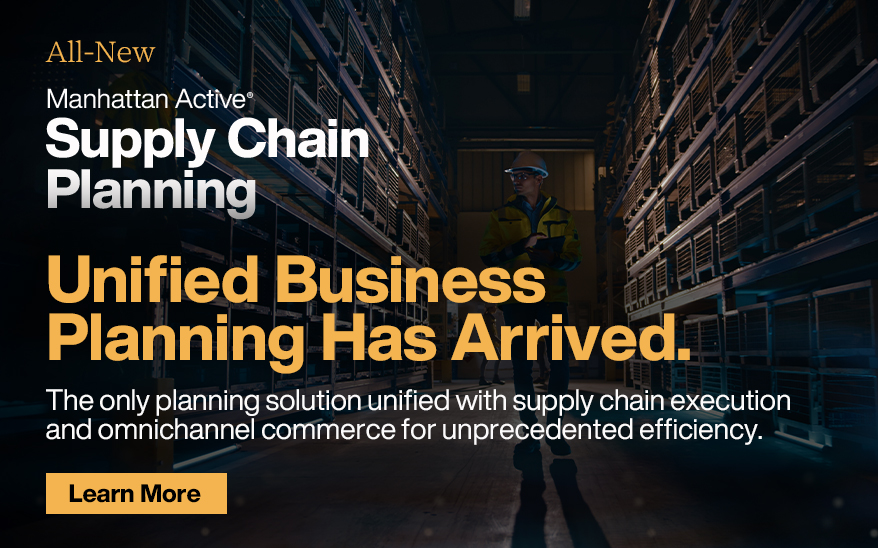What is Unified Commerce? It’s the Future of Retail
- June 21, 2023
- Manhattan Staff
What is unified commerce?
Unified commerce is a retail business approach that combines all retail systems to provide a consistent shopping experience across all selling channels. This allows associates to track cross-channel customer data, view enterprise-wide inventory, and access all order history, while simultaneously providing customers the flexibility to purchase products and navigate the retail experience seamlessly, either digitally or in-store.
To provide this experience, retailers need a unified commerce platform.
What is a unified commerce platform?
A unified commerce platform leverages real-time data regarding customers, inventory, and distribution network in one place—effectively connecting the back end of retail operations to the front end. Point of sale (POS), inventory management, customer relations management (CRM), order management, and fulfillment management are all accessed within a single view and delivered symbiotically in one solution. With a unified commerce platform, retailers possess the technology capabilities required to keep the promises they make and meet modern omnichannel customer demands.
Why is unified commerce so important to retail today?
When executed properly, according to the 2023 Unified Commerce Benchmark for Specialty Retail: “A unified commerce approach ensures every shopping journey becomes a brand loyalty opportunity” and “represents a significant opportunity to grow revenue.” Retailers who use a leading Unified Commerce strategy see a revenue increase of 3 to 6 times compared to those who do not. A specialty retailer could benefit from $40M of extra revenue for every billion dollars generated annually by improving their Unified Commerce maturity.
The retail world today—and consumerism as a whole in this new omnichannel landscape—revolves around convenience. Digital technological advances have placed the power in customer’s hands (literally) and retailers need to respond with agile solutions to meet omnichannel customer expectations. The reality is customers no longer see separate channels and digital is no longer a differentiator in retail.
Still, why do retailers need to expend more resources on a unified commerce platform when providing baseline omnichannel experiences will also reach a customer both digitally and in-store? That comes down to the difference between the two.
What is the difference between unified commerce vs. omnichannel commerce?
Both unified commerce and omnichannel commerce share the same endgame in creating a better retail experience for customers. However, while the two terms seem interchangeable, there are key differences between unified commerce and omnichannel commerce:
Omnichannel commerce consists of:
- Store solutions focused on customer-facing, front-end retail experiences.
- Customer fulfillment experiences that provide brand, messaging, and process consistency, but are not connected to all other sales channels.
- Customizations and updates are made to each channel separately.
- Does not combine cross-channel data and insights.
- Ends at multi-channel expansion.
Unified commerce delivers:
- A connected retail experience, merging all sales channels together.
- Unified backend and frontend systems into one unified platform.
- Tracking of all data and channel insights from a single source.
- Real-time data visibility of all channels, customer interactions, products, and management systems that can be leveraged to gain a better business and customer perspective.
- Simplified customizing of individual retail customer experiences via access to a 360-degree profile of every interaction with the retailer’s brand in every channel.
Essentially, a unified commerce platform is used to provide the optimal omnichannel customer experience, but it does so by connecting aspects of the retail network outside of the omnichannel experience scope.
What are the four main factors that contribute to unified commerce?
There are four main factors of unified commerce that enable optimized scalability, adaptability, and visibility, as well as seamless connectivity of customer and associate interactions. The four main factors of unified commerce are:
I. Product visibility
Enterprise-wide inventory visibility and management allows everyone—from warehouse staff to retail associates and even customers—to see important product information, including what product is available, where product is in the retail network, where inventory is low and how quickly can product be sent to either a retail location or customer for fulfillment. With a unified commerce platform, customers should be able to access any ready inventory for purchase within the store network and choose the most convenient method of purchasing that product item that works for them.
II. Unified channels
By unifying all sales channels within a single unified commerce platform, retailers can easily keep track of all cross-channel purchases, sales, and promotions, accommodate omnichannel fulfillment requests—such as buy online, pick-up in-store (BOPIS), buy online, return in-store (BORIS) curbside pickup, ship from store, and endless aisle option—and gain access to data from every channel to review performance and fine-tune inventory strategies.
III. Integrated systems
With a unified commerce platform, all backend and frontend systems are connected and work as a cohesive unit to provide retailers with the ability to adapt and scale all functionality to their specific business needs. It enables the unification of all stores, customer services, and distribution processes to achieve business goals, and doesn’t require time and resources spent on multiple solution providers. This unification provides access to actionable enterprise-wide data from multiple touchpoints with all customer and inventory data accessible from a single view, regardless of channel. When all systems are working from one centralized platform, it allows for the integration of new technologies and seamless receiving of solution upgrades that address and keep up with omnichannel trends.
IV. Customer engagement
Being able to engage with customers in every selling channel from every touchpoint unlocks customization and personalization of a single customer’s buying journey, from the moment they first interact with a retailer’s brand to well after the sale. A unified commerce associate experience means access to a customer’s order history, wishlists, omni cart, brand interactions, and social engagement opportunities whenever and wherever customers need it, via store associates or contact center employees. This not only helps build a deeper understanding of what customers want but most importantly allows the retailer to keep the promises it makes to its customers.
These factors that make up unified commerce lead to beneficial outcomes for retailers who leverage it properly. But what exactly are the benefits of unified commerce? And why is it so important to the future of retail?
What are the consumer benefits of unified commerce?
Unified commerce not only unifies the digital and physical retail world but also allows retailers to understand their customers on a personal level.
The consumer experience benefits of unified commerce are substantial and play a large role in whether or not that customer will turn into a repeat shopper. These benefits include:
- Enabling customers to research an item online—with real-time, network-wide inventory visibility—and providing the option to buy online, pickup in-store, ship-from-store, ship to another store location, or local delivery.
- Arming retail associates with tracked real-time customer data, unlocking personal customer insights, preferences, and habits in every channel to further nurture and customize the retail experience.
- Allowing digital customers to continue their shopping experience in-store, where they can cancel their initial order or shop for items to add to their existing Omni cart, while also providing retail associates cross-sell/upsell opportunities during customer pickup/check out.
- Empowering retail associates to switch fulfillment methods or make order changes based on customer requirements and requests via two-way communication.
- Enabling customers to initiate cancellations and modifications or returns and exchanges after their purchase with digital self-service, regardless of initial sales channel.
- Providing customers with order update notifications and the option of engaging the contact center or associates via communication regarding order cancelations, shipping status, and order info.
Being able to understand why a customer is shopping with your brand and tailoring experiences around customer intent can make customers feel seen and heard throughout their buyer’s journey. It lets them know that their needs are the top priority, with a level of personalization and transparency that ultimately leads to brand loyalty.
In the 2023 Unified Commerce Benchmark, sponsored by Manhattan, Google, and Zebra, the Search & Discovery section of the research conducted shows that there is a 33% higher conversion rate for shoppers who initiate engagement with a retailer with a product search, 50% of retail leaders personalize recommendations on their web homepage and 62% provide real-time inventory visibility on the product detail page.
What are the solution benefits of unified commerce?
The technological and systematic capabilities of selling on one unified commerce platform also allow retailers to consolidate payment processing, streamline fulfillment functions, and drive connected retail solutions that constantly adapt and improve retail operations — as well as optimize the customer experience. These key capabilities include:
- Global payment processing in any channel is available on a single platform, allowing associates to manage and accept any type of payment from any channel or region, with universal reporting data.
- Payment flexibility, including paying by any combination of or by way of gift cards, loyalty points, store credit, mobile wallets, pay-later apps, and store credit cards.
- Integration of all business systems on one platform that enables the retailer to scale and adapt to match business needs.
- Cloud-native unified commerce platforms receive all updates and upgrades automatically and without disruption.
- Accurate real-time inventory enables seamless movement of inventory based on demand or customer preferences, providing easier fulfillment.
- A single view of order history, inventory, and business analytics across channels, enabling precise data that can help predict future customer behavior.
These unified commerce capabilities are defining how customers shop and, in some cases, differentiating retailers who adopt a unified commerce approach.
Retailers who adopt unified commerce are surviving and thriving.
Beyond the technology and consumer benefits above, unified commerce allows frictionless connectivity of the retail experience that leads to significant beneficial business and financial outcomes as well.
Manhattan customer Brooks Brothers is a good example.
Brooks Brothers, the oldest American apparel brand dating back to 1818, is a retailer known for providing stylish modern clothing for men, women, and children.
When the COVID-19 pandemic forced non-essential businesses to close their store locations nationwide, Brooks Brothers had to pivot from a pre-pandemic 35% digital business to 100% digital overnight.
It was an unprecedented supply chain disruption that left some businesses searching for answers. Luckily, Brooks Brothers already had theirs in hand.
The retailer had already selected Manhattan Active® Omni in 2018 as a response to its previous lackluster ecommerce fulfillment. Before Manhattan, Brooks Brothers operated one distribution center (DC) for ecommerce fulfillment. Its ecommerce network consisted only of unsold product that originally lived in physical retail locations but had become excess, out-of-season inventory. That inventory was then shipped to the ecommerce DC and sold at a discounted price. Not the ideal product life-cycle.
Brooks Brothers saw an opportunity with Manhattan Active Customer Service and Engagement capabilities to fulfill its ecommerce orders directly from local stores, cutting down the time it took for the package to get to its customers and enabling the retailer to sell products at full price from local retail locations, effectively increasing margins.
Little did they know at the time, this omnichannel flexibility would also be vital to sales during the COVID-19 pandemic. Flash forward to 2020 with store closures and an impending holiday season around the corner, Brooks Brothers relied on Manhattan Active Omni to get through. Instead of struggling to meet a flood of ecommerce orders with its previous legacy software, the retailer thrived with ship-from-store and pickup in-store fulfillment capabilities from its closed retail locations.
The retailer also made life easier for their associates and set themselves up for future success with a unified commerce platform that allows endless upgrades and capabilities to be added that fit Brooks Brothers specific business needs. With an agile, evergreen solution now at the helm, the oldest American apparel brand can keep its title moving forward with a unified commerce platform that is ready for any unforeseen disruption or future omnichannel customer trends.
“Without having the scalability of Manhattan Active Omni, we never would’ve made it through that holiday season. However our customers want to shop we can now support them. If we have the inventory and they want it, we can get it to them.
We also have a good path forward for what comes next. We’ll have a unique situation where we have OMS, promotion, store inventory management, and point of sale all connected. From an endless aisle perspective, I like to call that The Holy Grail.”
- Todd Treonze, Senior Vice President and Chief Information Officer at Brooks Brothers
Fashion retailer PacSun gave an even bigger stamp of approval for what unified commerce has enabled their stores to do.
“Ship from store saved the company.”
- Michael Relich, Co-CEO, PacSun
Why is having a unified commerce platform so important to the present and future of retail?
In the current retail landscape, most retailers provide basic omnichannel capabilities. However, the leaders in retail are separating themselves by providing a more nuanced approach. They offer the same capabilities but with more depth, nuance, transparency, and personalization. The biggest discrepancies in the 2023 Unified Commerce Benchmark include:
- Rich Findability- 80% of retail leaders enable customers to filter by fulfillment method, compared to 21% non-leaders.
- Immersive Storytelling- 87% of leaders publish detailed content on sustainability efforts, compared to 58% of non-leaders.
- Unified Basket- 93% of leaders enable the ability to check product availability status by store, compared to 53% of non-leaders.
- Payment Flexibility- 86% of leaders provide loyalty points redemption for payments, compared to 52% of non-leaders.
- Consultative Expertise- 91% of leaders empower store associates to check online purchase history in-store, compared to 67% of non-leaders.
As far as the future of retail is concerned, according to the US Census Bureau, today’s specialty retail shoppers are made up of 22% Millennials, 20% Generation Z, and 11% Generation Alpha, combining for over half of customers — a number will only continue to rise.
As stated in the Unified Commerce Benchmark:
“A third of the U.S. population is younger than Amazon. For them, one-click ordering, and fast and free shipping aren’t game-changers. They are just what’s expected from modern retail.”
The lines dividing the digital and physical retail world will only continue to be further blurred as the two channels progressively merge into one retail experience. Having a unified commerce platform is imperative to making good on the promise of providing a consistent, convenient omnichannel shopping experience, either online, on a mobile device, or in-store.
Possessing the right digital tools to create a unified commerce experience for both retail associates and customers is a requirement in this new age of hyper-convenience consumerism. And staying ahead of the curve and getting out in front of new unified commerce technologies is the key to creating profitable shopping experiences in the future.
Manhattan Active Omni can lead the way…
The Manhattan Active Omni suite is built to provide optimal omnichannel retail experiences for your customers with a unified commerce platform that profitably connects every aspect of your retail network. Born in the cloud, Manhattan Active Omni is a comprehensive portfolio of solutions and services that is always current and fully extensible.
Its suite of omnichannel software solutions—including Customer Engagement, Point of Sale, Store Inventory & Fulfillment, and Order Management—deliver a unified approach to selling, engagement, and fulfillment in a single cloud-native app. It is the ultimate unified commerce platform, with the flexibility and scalability to provide associates with everything they need to navigate the omnichannel world and it is built to deliver truly omnichannel customer experiences for today's and tomorrow’s retail shoppers.
Want to learn more about how Manhattan Active Omni can help your stores? See how Lamps Plus is able to deliver a “peaceful” omnichannel experience with Manhattan.
What does your unified commerce look like? Request a demo or contact us below to unlock your optimized unified commerce experience.
Deliver On Your Promise to Customers
Get in touch with the Manhattan team to see how we can help.





